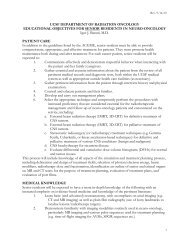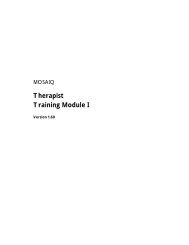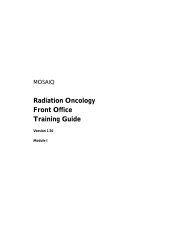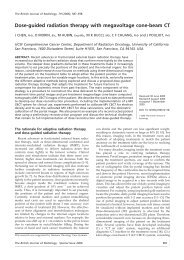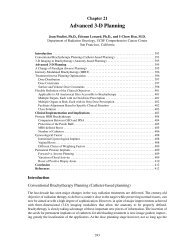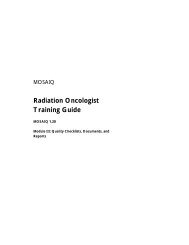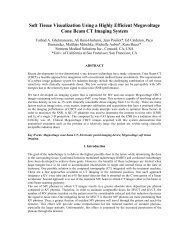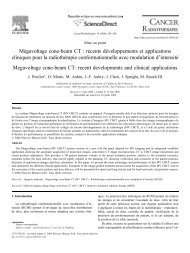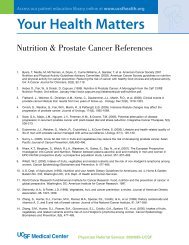Improved critical structure sparing with biologically based IMRT ...
Improved critical structure sparing with biologically based IMRT ...
Improved critical structure sparing with biologically based IMRT ...
You also want an ePaper? Increase the reach of your titles
YUMPU automatically turns print PDFs into web optimized ePapers that Google loves.
<strong>Improved</strong> <strong>critical</strong> <strong>structure</strong><br />
<strong>sparing</strong> <strong>with</strong> <strong>biologically</strong> <strong>based</strong><br />
<strong>IMRT</strong> optimization<br />
X.Sharon Qi, Vladimir A. Semenenko and X. Allen Li<br />
Department of Radiation Oncology, Medical College of<br />
Wisconsin
Introduction<br />
DVH <strong>based</strong> algorithm ignore the nonlinear dose<br />
response of both tumor and normal <strong>structure</strong><br />
Dose-<strong>based</strong> optimization is insufficient to predict<br />
any biological end point of radiotherapy<br />
Biologically <strong>based</strong> radiation treatment planning<br />
can substantially improve the quality of the plan<br />
generated
Purpose<br />
to study the impact of using biological models on<br />
plan quality by evaluating commercially available<br />
treatment planning systems
Methods and materials
A. TPS<br />
TPS: CMS (Monaco, XiO)<br />
Philips Pinnacle<br />
Tomotherapy
Biological objective functions in TPS
Physical objective functions
B. Study design<br />
Five clinical cases: brain, H&N, lung, pancreas<br />
and prostate<br />
The original treatment plans were generated by<br />
using XiO or Tomotherapy<br />
Two physically <strong>based</strong> <strong>IMRT</strong>(p<strong>IMRT</strong>) and two<br />
<strong>biologically</strong> <strong>based</strong> (b<strong>IMRT</strong>) plans were generated<br />
for each cases utilizing different TPSs<br />
Same planning CT and <strong>structure</strong> set<br />
Same beam numbers and orientations
Fix angles:<br />
p<strong>IMRT</strong>: XiO (XiO)<br />
p<strong>IMRT</strong>: Pinnacle (Pinn_phy)<br />
b<strong>IMRT</strong>: Monaco (Monaco)<br />
b<strong>IMRT</strong>: Pinnacle (Pinn_bio)<br />
Rotation:<br />
Tomotherapy (Tomo)
C. Plan comparison (p<strong>IMRT</strong> vs. b<strong>IMRT</strong>)<br />
DVH<br />
Heterogeneity index (HI): the ratio of the<br />
minimum dose delivered to the hottest 5% of the<br />
PTV to the minimum dose delivered to the<br />
hottest 95% of the PTV<br />
Conformity index (CI): the ratio of volume inside<br />
the isodose surface corresponding to the<br />
prescription dose compared to the volume of the<br />
target<br />
Overall plan ranking index (fEUD)
EUD<br />
The uniform dose that gives the same biological effect as a<br />
given nonuniform dose distribution<br />
a: the tumor or normal tissue specific parameter<br />
a=1/n for the relationship of Lyman model<br />
Malignant tumor targets general have large negative values<br />
serial-type organ has a large positive value (penalize hot<br />
spots)<br />
parallel <strong>structure</strong> organ use a small positive value
fEUD: EUD-<strong>based</strong> figure-of-merit<br />
Weighting factors, correspond to the<br />
complication probability (for ith<br />
OAR) and/or control probability for<br />
jth target<br />
The relative importance factor<br />
between the weighted sums of EUDs<br />
for all targets and OARs
Results<br />
A. Dose distributions and DVHs
Head and Neck case in target: Similar
Head and Neck case: DVH of OARs
Prostate case
Prostate case
Comparison of the dose ranges from the minimum to maximum doses<br />
and the mean doses for the five cases(1)
Comparison of the dose ranges from the minimum to maximum doses and the mean<br />
doses for the five cases(2)
<strong>IMRT</strong> plans offer improved OAR <strong>sparing</strong><br />
The target coverage for both p<strong>IMRT</strong> and b<strong>IMRT</strong><br />
plans are comparable; Tomo plans are slightly<br />
more uniform<br />
Monaco plans show slightly more heterogeneous<br />
dose distributions in targets compared <strong>with</strong> other<br />
plans
B. Dose conformity and hetergenetiy<br />
Monaco plans and Pinn_bio plans: more conformal<br />
Monaco: similar or higher HI<br />
Pinn_phy and Pinn_bio: similar HI<br />
Tomo: similar or lower values of CI and HI
C: The equivalent uniform dose
All five plans give similar EUDs<br />
Monaco plan results in slightly greater EUDs<br />
values in 11 out of 12 targets in all five cases<br />
Compared to Pinn_phy plans, Pinn_bio plans<br />
lead to 7 out of 12 targets receiving higher EUDs,<br />
while 32 out of 37 OARs receive lower EUDs<br />
The Monaco and Pinn_bio plans yield similar<br />
OAR <strong>sparing</strong>
D. Overall plan figure-of-merit(fEUD)
E. DVH dependence of parameter a<br />
cord Right parotid
Conclusion<br />
The use of biological models in treatment<br />
planning optimization can generate <strong>IMRT</strong> plans<br />
<strong>with</strong> significantly improved normal tissue<br />
<strong>sparing</strong> <strong>with</strong> similar or slightly increased dose<br />
heterogeneity in target<br />
Caution should be exercised in choosing<br />
appropriate models and/or model parameters<br />
and in evaluating the plan obtained when using<br />
the <strong>biologically</strong> <strong>based</strong> treatment planning system
Thank you!




